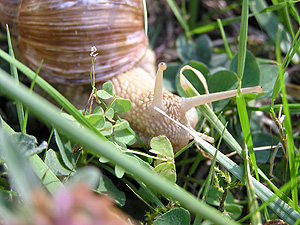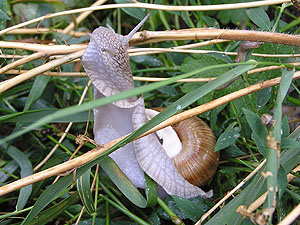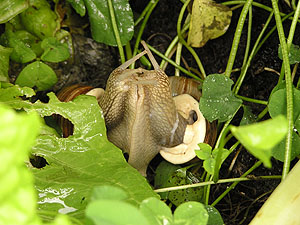| Diese Seite auf Deutsch! |
|
The Roman SnailHelix pomatia Linnaeus, 1758 |
Systematics:
 Photo: Robert Nordsieck. |
![]() MolluscaBase eds.
(2025):
Helix pomatia Linnaeus, 1758.
MolluscaBase eds.
(2025):
Helix pomatia Linnaeus, 1758.
![]() Identification of the Roman Snail and its
relatives by shell characters.
Identification of the Roman Snail and its
relatives by shell characters.
Introduction
With about 10 cm body length and up to 5 cm shell diameter, the Roman snail
is the largest Central European terrestrial snail. Together with other well
known domestic snails, such as the
grove snail (Cepaea nemoralis) and the
copse snail (Arianta arbustorum),
the Roman snail belongs to the helicid snails
(Helicidae). Roman snails are usually mainly active in the evening to forage for
food. In spite of its name in many languages, such as German ("Weinbergschnecke"
- vineyard snail), the Roman snail is not only encountered in vineyards, but is
an inhabitat of open hedges and bushes, and it also appears in settlements and
gardens. Since it is rare in some places, the Roman snail does not become a
garden pest, such as the large European round-back
slugs (Arionidae), but Roman snail can consume a lot of food. Roman snails
are exclusive herbivores, that specially like to feed on salad and other fresh
green food, but also do not refrain from feeding on wilted greens. (![]() More about feeding
and nutrition).
More about feeding
and nutrition).
Morphology (![]() More about morphology).
More about morphology).
 The cumbersome progress of a Roman snail on a way through the undergrowth reveals the underside of the foot sole. [RN] |
Hibernation (![]() More about hibernation).
More about hibernation).
 The courtship of the Roman snail. [RN] |
Reproduction (![]() More about reproduction).
More about reproduction).
Roman snails are hermaphrodites. Their copulation is preceded by an extended courtship phase, during which the partners may stab each other with a so-called love dart. The eggs are about 2 mm in size and are laid in an earth hole burrowed by the snail in early summer.
The juvenile snails hatched after about a month possess a small translucent shell and, at once, crawl around to forage for food. Only a small percentage of the juveniles make it to adulthood, which usually is reached after the second hibernation. Those few snails, hwever, may reach an old age. Measurements in Bavaria have proved that Roman snails can at least grow to become 20 years of age. There are single cases of Roman snails several decades old.
Economy (![]() More about economy).
More about economy).
 Allotments in a snail farm in Elgg (Switzerland). [RN] |
![]() The history of snail cultivation.
The history of snail cultivation.
In nature, therefore, many Roman snail species are protected by law and may not be collected anymore. Especially the Roman snail Helix pomatia and the related brown garden snail (Cornu aspersum) are cultivated in snail farms (Hélicicultures). Apart from France, especially Germany, Switzerland and Austria have become a centre for ecological and economical snail farming in recent time.
Relatives (![]() More about relatives of the Roman snail).
More about relatives of the Roman snail).
The closest relatives of the Roman snail are the helicid snails (Helicidae). In this very large snail family, there are the diverse and colourful banded snails (Cepaea), as well as the copse snail (Arianta arbustorum) and the lapidary snail (Helicigona lapicida) with its uncommon lenticular shell.
There are, however, also very many helicid snail species in the Mediterranean region. Among the best known Mediterranean helicid species, there are, for example, the sandhill snail (Theba pisana) and the chocolate banded snail (Eobania vermiculata), as well as mainly Iberian snail species, such as the milk snails (Otala lactea). Across the southern Balkan Peninsula and Asia Minor, there are for example the Lycian rock snails (e.g. Codringtonia lycia), and on the Iberian Peninsula there are also the Iberian snails (e.g. Iberus gualterianus).